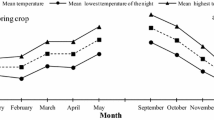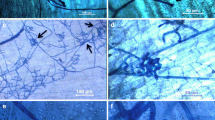Summary
Histochemical evaluation of the wound-induced suberization and periderm formation, the processes of wound healing, in potato tubers (Solanum tuberosum L.) showed that both the processes occur most rapidly at 25°C. Wound-healing is delayed at 10 or 15°C while a temperature of 35°C prevented periderm formation and retarded suberization. Gamma irradiation up to 100 Gy, the optimal dose for sprout inhibition, did not affect suberization, which suggests that the DNA-replicating mechanism is more radiation-sensitive than suberin biosynthesis. A dose of 20 to 30 Gy, which had no effect on sprouting inhibited wound periderm formation indicating that meristems in resting buds are apparently less sensitive to irradiation than nuclei of the potential periderm cells. It seems probable that a major cause for the bacterial soft rot occurring in tubers when stored under high tropical ambient temperatures or when irradiated for sprout inhibition is due to an impairment of the wound periderm formation.
Zusammenfassung
Um die möglichen Gründe für den gesteigerten mikrobiellen Abbau von Kartoffeln während der Lagerung unter tropischen Umweltbedingungen oder nach der Bestrahlung mit Röntgenstrahlen zur Keimhemmung aufzuklären, wurde der Einfluss von Temperatur und Bestrahlung auf die durch Verletzung induzierte Suberin-und Peridermentwicklung untersucht.
Es zeigte sich, dass sowohl die Suberinisierung als auch die Peridermentwicklung bei 25°C schneller verlaufen, während sie bei 10–15°C verlangsamt sind. Temperaturen über 35°C verhindern die Peridermbildung und verzögern die Suberinisierung (Tabelle 1). Das Ausmass der Polyphenolbildung war im 1 mm unter der Verletzung bei 20, 25 und 28–30°C ähnlich der bei 10°C und 15°C während es bei 35°C verringert war (Abb. 2).
Histochemische Untersuchungen zeigten, dass die Suberinisierung in unbestrahlten Knollen und in Knollen, die bis zu 100 Gy erhalten hatten, der optimalen Dosis für die Keimhemmung, im gleichen Ausmass erfolgte (Tabelle 2). Aus diesen Ergebnissen wird geschlossen, dass der Verdopplungsmechanismus der DNS auf Bestrahlung empfindlicher reagiert als die Suberinsynthese. Der Gehalt an Polyphenolen in den suberinisierten Zellschichten war in bestrahlten Knollen vergleichsweise höher (Tabelle 3). 20–30 Gy an Röntgenstrahlen reichten aus, um die Wundperidermbildung zu unterbinden (Tabelle 2 und Abb. 1), während für die Keimhemmung eine Minimaldosis von 50 Gy benötigt wurde. Das bedeutet, dass die Meristeme in den ruhenden Knospen auf die Bestrahlung weniger empfindlich reagieren als die Kerne in den potentiellen Peridermzellen. Die suberinisierten Zellschichten können von der Wundoberfläche unbestrahlter Knollenhälften leicht abgeschoben werden, während das bei Knollen, die einer Bestrahlung von 20 Gy und mehr ausgesetzt waren, nicht möglich ist. Dieser Unterschied könnte als Methode zur Identifizierung bestrahlter Knollen verwendet werden.
Die Ergebnisse zeigen, dass die Schädigung der Wundperidermentwicklung ein Hauptgrund für die gesteigerte mikrobielle Fäule von Kartoffelknollen während der Lagerung bei tropischen Temperaturen oder nach Bestrahlung zur Keimhemmung ist.
Résumé
L'influence de la température et de l'irradiation sur la subérisation d'une blessure occasionnée et sur le développement du périderme a été étudiée, dans le but d'expliquer les déchets de pourritures microbiennes sur des tubercules mis en conservation sous des conditions de climat tropical ou à la suite d'une exposition aux rayons gamma en vue de l'inhibition de la germination.
Le développement du périderme et la subérisation se sont effectués rapidement à 25°C mais les réactions ont été retardées à 10 ou 15°C. Une température de 35°C a empêché la formation de périderme et retardé la subérisation (tableau 1). Le taux de polyphénol dans la 1ère couche d'1 mm sous la blessure était sensiblement le même à 10, 15, 20, 25 et 28–30°C mais il avait diminué à 35°C (figure 2).
Les résultats de l'analyse hystochimique ont montré que la subérisation avait progressé à vitesse égale pour des tubercules non-irradiés et des tubercules irradiés à plus de 100 Gy, dose optimale correspondant à l'inhibition de la germination. Ces résultats suggèrent que le mécanisme de réplication de l'ADN est plus sensible à la radiation que la biosynthèse de la subérine. Le niveau de polyphénols dans les couches cellulaires en voie de subérisation était plus élevé dans les tubercules irradiés que dans les tubercules non irradiés (tableau 3). 20 à 30 Gy de rayons gamma ont suffi pour empêcher la formation du périderme de cicatrisation (tableau 2 et figure 1) tandis que la dose minimale nécessaire à l'inhibition de la germination était de 50 Gy. Les méristèmes de germes en dormance seraient donc moins sensibles à l'irradiation que les noyaux des cellules du périderme potentiel. Les couches cellulaires subérisées peuvent facilement se détacher de la surface endommagée lorsqu'il s'agit de tubercules non irradiés, tandis qu'elles sont difficilement séparables dans le cas de tubercules exposés à 20 Gy ou plus. Cette différence peut conduire à une méthode d'identification des tubercules irradiés.
La recrudescence des pourritures microbiennes sur tubercules mis en conservation à des températures tropicales ou exposés aux rayons gamma en vue d'inhibition de la germination, semble liée principalement au ralentisement du développement d'un périderme de cicatrisation.
Similar content being viewed by others
References
Agrios, G. N., 1969. Plant pathology, p. 113. Academic Press, New York.
Ali, S. A., D. C. Nelson & T. P. Freeman, 1975. Suberization and periderm development in Norchief and Red Pontiac potatoes.Am. Potato J. 52: 201–209.
Artschwager, E. F., 1927. Wound periderm formation in the potato as affected by temperature and humidity.J. agric. Res. 35: 995–1000.
Borchert, R. & J. D. McChesney, 1973. Time course and localization of DNA synthesis during wound healing of potato tuber tissue.Develop. Biol. 35: 293–401.
Borchert, R., J. D. McChesney & D. Watson, 1974. Wound healing in potato tuber tissue. Phosphon inhibition of developmental processes requiring protein synthesis.Pl. Physiol. 53: 187–191.
Dean, B. B. & P. E. Kolattukudy, 1977. Biochemistry of suberization.Pl. Physiol. 59: 48–54.
El-Sayed, S. A., 1975. Increasing rotting in irradiated potatoes in relation to phytoalexin, rishitin and phytuberin formation.Egypt. J. Hort. 2: 187–197.
El-Sayed, S. A., 1978. Phytoalexins as possible controlling agents of microbial spoilage of irradiated fresh fruits and vegetables during storage. In: Food preservation by irradiation Vol. 1, p. 179–193. International Atomic Energy Agency, Vienna.
Fox, R. T. V., J. G. Manners & A. Myers, 1971. Ultrastructure of entry and spread ofErwinia carotovora var.atroseptica into the potato tubers.Potato Res. 14: 61–67.
Kolattukudy, P. E. & B. B. Dean, 1974. Structure, gas chromatographic measurement and function of suberin synthesized by potato tuber tissue slices.Pl. Physiol. 54: 116–121.
Mader, H., 1958. ‘Kork’. In: W. Ruhland (Ed.), Handbuch Pflanzenphysiologie, p. 282–299. Springer, Berlin.
Miller, M., 1980. Effect of post-harvest treatment on the shelf-life of summer crop potatoes.J. Food Sci. 45: 716–717.
Nielsen, N. K., 1973. A quick microtechnique for inspection of potato periderm or wound periderm formation.Potato Res. 16: 180–182.
Penner, H., 1970. Identification of potatoes by lack of wound periderm formation. Colloquium on the identification of irradiated foodstuffs, Luxembourg, p. 67–71.
Pérombelon, M. C., 1973. Sites of contamination and numbers ofErwinia carotovora present in stored and seed potato stocks in Scotland.Ann. Appl. Biol. 74: 59–65.
Priestly, J. H. & L. M. Woffendon, 1923. The healing of wounds in potato tubers and their propagation by cut sets.Ann. appl. Biol. 10: 76–101.
Ogawa, M., R. Majima, I. Uritani & M. Namiki, 1968. Effect of gamma-ray irradiation on metabolic changes in potato tubers in response to cutting.Plant & Cell Physiol. 9: 511–518.
Smith, O., 1968. Potatoes: Production, storing and processing. AVI, Westport, Conn.
Smith, W. L. & H. F. Smart, 1955. Relation of soft rot development to protective barriers in Irish potato slices.Phytopathology 45: 649–654.
Soliday, C. L., P. E. Kolattukudy & R. W. Davis, 1979. Chemical and ultrastructural evidence that waxes associated with suberin polymer constitute the major diffusion barrier to water vapour in potato tuber (Solanum tuberosum L.).Planta 146: 607–614.
Swain, T. & W. E. Hillis, 1959. The phenolic constituents ofPrunus domestica L. The quantitative analysis of phenolic constituents.J. Sci. Food Agric. 10: 63–71.
Thomas, P. & H. Delincée, 1979. Effect of gamma irradiation on peroxidase isoenzymes during suberization of wounded potato tubers.Phytochemistry 18: 917–921.
Thomas, P., A. N. Srirangarajan, M. R. Joshi & M. T. Janave, 1979. Storage deterioration in gamma irradiated and unirradiated Indian potato cultivars under refrigeration and tropical temperatures.Potato Res. 22: 261–278.
Author information
Authors and Affiliations
Rights and permissions
About this article
Cite this article
Thomas, P. Wound-induced suberization and periderm development in potato tubers as affected by temperature and gamma irradiation. Potato Res 25, 155–164 (1982). https://doi.org/10.1007/BF02359802
Accepted:
Issue Date:
DOI: https://doi.org/10.1007/BF02359802




